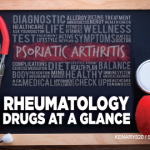 Anaphylaxis is a common adverse drug effect reported to the U.S. Food & Drug Administration (FDA) via MedWatch, the FDA’s Adverse Event Reporting System (FAERS), and 14 drugs commonly prescribed by rheumatologists are on the list of the top 50 drugs that can cause anaphylaxis.1
Anaphylaxis is a common adverse drug effect reported to the U.S. Food & Drug Administration (FDA) via MedWatch, the FDA’s Adverse Event Reporting System (FAERS), and 14 drugs commonly prescribed by rheumatologists are on the list of the top 50 drugs that can cause anaphylaxis.1
Health professionals, patients and consumers all voluntarily report adverse events to the FDA. Individuals may also report adverse drug events to manufacturers. By regulation, when a manufacturer receives a report from a healthcare professional or consumer, it is required to send that report to the FDA.2
The database of reported reactions supports the FDA’s post-marketing safety surveillance program for drug and therapeutic biologic products. It’s used to identify new safety signals for marketed pharmaceuticals. If a potential safety concern is identified in the database, the FDA may take regulatory action, such as updating a product’s label, restricting a product’s use, communicating new safety information to health professionals and the public, or removing a product from the U.S. market. Although a drug can have a temporal association with a reaction when prescribed, causality is often difficult to determine. Consequently, firm conclusions about the prevalence, incidence and causality of adverse reactions cannot be determined from these voluntary reports.
Anaphylaxis is a well-known, severe adverse reaction for some drug classes, but newer drugs with novel mechanisms of action may contribute to anaphylaxis in unpredictable ways. Yu et al. evaluated the top drugs and drug classes associated with anaphylaxis and anaphylaxis followed by death reported through FAERS. Using the search terms anaphylactic shock or anaphylactic reaction and sorting cases by generic drug names, the researchers counted and trended FAERS reports from 1999 through 2019 in which a drug was associated with anaphylaxis or anaphylaxis followed by death.1 The top 50 drugs and drug classes associated with anaphylaxis were identified.
During the time frame reviewed, 17,506,002 adverse drug events were reported, of which 47,496 (0.27%) events reported an anaphylactic reaction or anaphylactic shock. Of these 47,496 anaphylactic events, 2,984 (6.3%) anaphylactic incidents proved fatal. The median age was 52, and 63% of the patients were women. Reports from the U.S. made up 13,899 of 34,381 (40.43%) of all FAERS anaphylactic reports that listed a country. The other reporting countries included Canada, Germany, France, the U.K. and Japan.
The top five classes of drugs associated with anaphylaxis were:
1. Antibiotics, comprising 24.9% of reactions;
2. Monoclonal antibodies, comprising 13.1% of reactions;
3 & 4. Non-steroidal anti-inflammatory drugs (NSAIDs) and acetaminophen, comprising 8.8% of reactions; and
5. Intraoperative agents (e.g., atracurium, cefazolin, fentanyl and lidocaine), comprising 8.6% of reactions.
At 4.4%, omalizumab was the drug with the most reported incidents of anaphylaxis. The high incidence of omalizumab-associated anaphylaxis was due to its many on-label and off-label uses, such as treating immediate-hypersensitivity and IgE-mediated inflammation, including idiopathic anaphylaxis, which may confound results.



